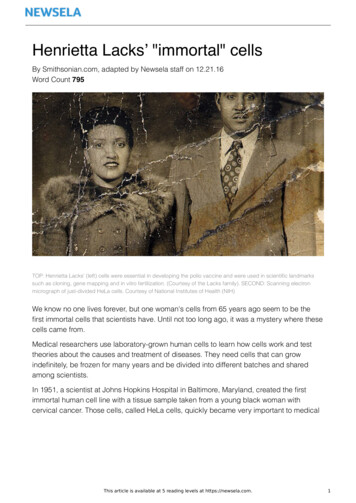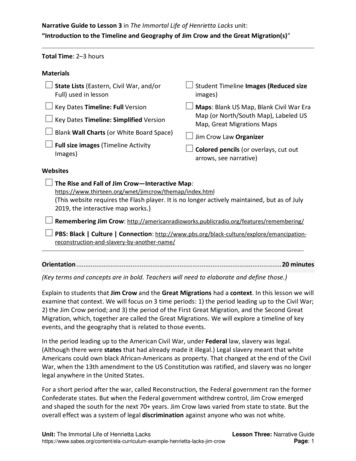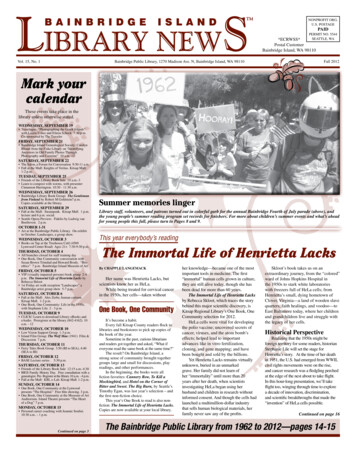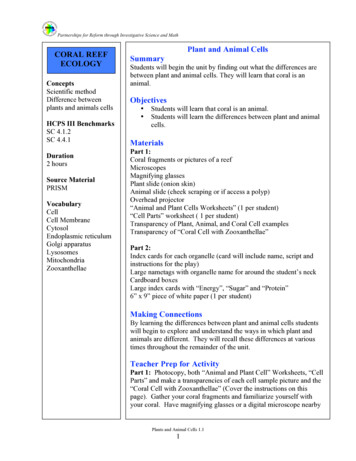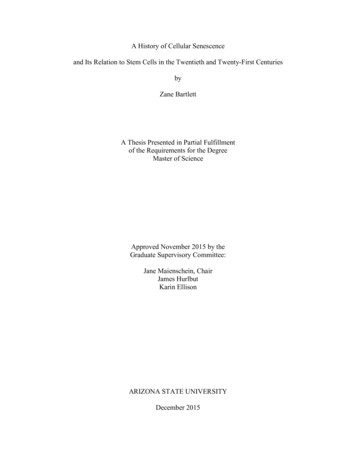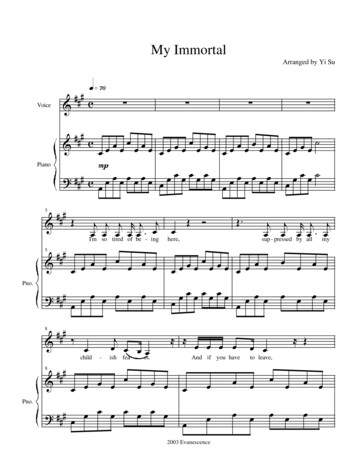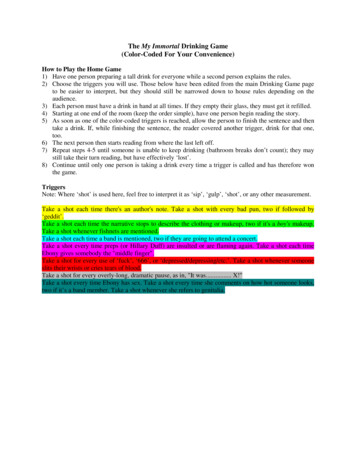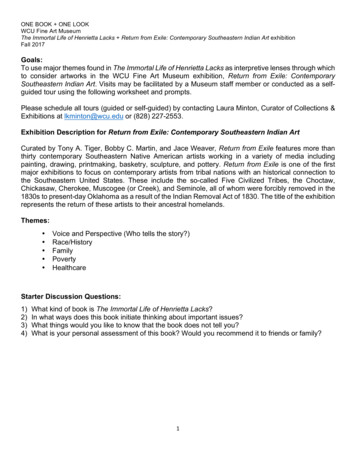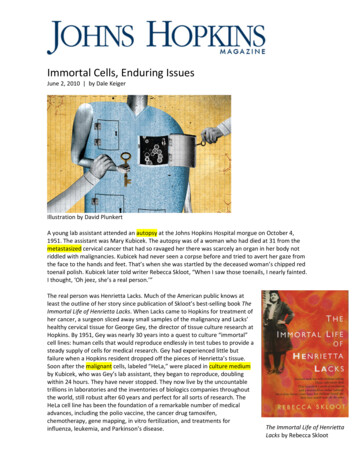
Transcription
Immortal Cells, Enduring IssuesJune 2, 2010 by Dale KeigerIllustration by David PlunkertA young lab assistant attended an autopsy at the Johns Hopkins Hospital morgue on October 4,1951. The assistant was Mary Kubicek. The autopsy was of a woman who had died at 31 from themetastasized cervical cancer that had so ravaged her there was scarcely an organ in her body notriddled with malignancies. Kubicek had never seen a corpse before and tried to avert her gaze fromthe face to the hands and feet. That’s when she was startled by the deceased woman’s chipped redtoenail polish. Kubicek later told writer Rebecca Skloot, “When I saw those toenails, I nearly fainted.I thought, ‘Oh jeez, she’s a real person.’”The real person was Henrietta Lacks. Much of the American public knows atleast the outline of her story since publication of Skloot’s best-selling book TheImmortal Life of Henrietta Lacks. When Lacks came to Hopkins for treatment ofher cancer, a surgeon sliced away small samples of the malignancy and Lacks’healthy cervical tissue for George Gey, the director of tissue culture research atHopkins. By 1951, Gey was nearly 30 years into a quest to culture “immortal”cell lines: human cells that would reproduce endlessly in test tubes to provide asteady supply of cells for medical research. Gey had experienced little butfailure when a Hopkins resident dropped off the pieces of Henrietta’s tissue.Soon after the malignant cells, labeled “HeLa,” were placed in culture mediumby Kubicek, who was Gey’s lab assistant, they began to reproduce, doublingwithin 24 hours. They have never stopped. They now live by the uncountabletrillions in laboratories and the inventories of biologics companies throughoutthe world, still robust after 60 years and perfect for all sorts of research. TheHeLa cell line has been the foundation of a remarkable number of medicaladvances, including the polio vaccine, the cancer drug tamoxifen,chemotherapy, gene mapping, in vitro fertilization, and treatments forinfluenza, leukemia, and Parkinson’s disease.The Immortal Life of HenriettaLacks by Rebecca Skloot
Though the science and history in Skloot’s book are fascinating, they are not what has made it anational best seller. What has resonated with readers are the interwoven narratives of HenriettaLacks’ sad life and her daughter Deborah’s pursuit of knowledge about the mother she never knew.And there is one more thing. Text on the front cover of Skloot’s book reads, “Doctors took her cellswithout asking.” The inside flap continues, “Henrietta’s family did not learn of her ‘immortality’ untilmore than 20 years after her death, when scientists investigating HeLa began using her husband andchildren in research without informed consent. And though the cells had launched a multimilliondollar industry that sells human biological materials, her family never saw any of the profits.” Asignificant segment of the public harbors a deeply rooted mistrust of medical research. They do nottrust physicians and scientists to be open and honest with them. They fear that the privacy of theirmedical records will not be respected. They believe that someone somewhere is making a lot ofmoney off of drugs and biological products that were developed using pieces of tissue from peoplewho now are entitled to a piece of the profits. The Immortal Life of Henrietta Lacks speaks to thatskepticism, and above all is the vivid testament of how the Lackses feel they’ve been treated byphysicians, researchers, journalists, and corporations. The book will not reassure those alreadysuspicious that they are being used. Skloot says, “The thing that I hear more than anything [fromreaders] is, ‘We want to know what’s going on. We don’t want to feel like someone is doingsomething behind our backs.’” People want their individual humanity acknowledged and respected.Physicians and scientists and ethicists know this. They also know that doing the right thing, whichcan seem so straightforward to the public, gets more complicated all the time.WHEN LACKS CAME TO Johns Hopkins complaining that she had “a knot” on her womb, she enteredthe “colored ward” in the only major hospital in Baltimore that would treat an African American. Shereceived treatment that did not succeed but was state of the art in 1951.Simultaneous with her care, researchers at Hopkins and elsewhere weresearching for better ways to diagnose cervical cancer, which was killing 15,000women per year. They wanted a method of growing cervical cancer cells in thelab. That dovetailed with George Gey’s quest to create an immortal cell line.He received tissue samples from every cervical cancer patient who camethrough Hopkins’ door, including Lacks. Skloot states in her book that no oneasked Lacks for permission to take some of her tissue for Gey’s research.Documentary evidence of what was said at her bedside is scant and can betaken either as supporting Skloot’s assertion or arguing against anyretrospective moral judgment. Joann Rodgers, senior adviser for science,crisis, and executive communications at the School of Medicine, says, “PeopleI’ve talked to here have told me that physicians and scientists did talk to theirpatients if they wanted to take tissue, if they wanted to have them participatein research.” But Skloot has seen the consent form for Lacks’ treatment, and itdoes not include any mention of taking tissue for research. Howard Jones,who was Lacks’ gynecologist at the hospital, told Skloot that he never sought consent for tissuesamples. Present-day researchers at Hopkins acknowledge that in the 1950s, the very concept ofinformed consent as it’s now known was not on researchers’ minds. Daniel Ford, vice dean forclinical investigation at the School of Medicine, observes, “In that era, researchers got a little carriedaway with science and sometimes forgot the patient, and physicians treated patients the same wayclinically—it wasn’t shared decision making.” David Nichols, vice dean for education at the school,adds, “It was a relationship that was utterly imbalanced with respect to power and privilege. There’sa lingering sense, even today, of this imbalance, which has deep historical roots.”Before a procedure at Hopkins, patients now sign a consent form that includes this clause: “JohnsHopkins may dispose of any tissues or parts that are removed during the procedure. Johns Hopkinsmay retain, preserve, or use these tissues or parts for internal teaching or other educational
purposes without my permission, even if these tissues or parts identify me. However, Johns Hopkinsmay only use or disclose tissues or parts that identify me for research with my permission or withapproval of a review board governed by federal laws protecting these activities. If the tissues orparts do not identify me, Johns Hopkins may use them for scientific (research) purposes without mypermission or action by a review board.”Three things make consent a more complicated matter than simply reading a clause like that andinitialing the form. First, in some cases a patient may be asked to provide a biospecimen—tissue, aDNA swab, a blood sample—for a specific research project that has been approved by aninstitutional review board (IRB) and that requires specific consent. More often, though, researchersaccumulate biospecimens for future use in research that cannot be specified at the time ofcollection. In 1951, someone could have told Henrietta Lacks or her husband that they wanted cellsfrom Henrietta’s cervix to research a better means of diagnosing her cancer. They could not havetold her that someday science would want her cells for research on the effects of zero gravity inouter space, or for the study of leukemia or lactose intolerance or longevity or the mating ofmosquitoes, all of which has happened. Chi Van Dang, the School of Medicine’s vice dean forresearch, points out that scientists can’t possibly anticipate many types of future research. He says,“Do we have the trust of the public to say, ‘Look, we have your cells. What we’ll do with these cells, Ican tell you to some extent now, but five or 10 years from now they could be used in a completelydifferent way. With your permission, we need to have that flexibility.’” Scientists worry thatstringent regulations requiring specific consent for any future uses of biospecimens could hamstringresearch.But a recent court case demonstrates that Dang’s hoped-for flexibility on the part of the publiccannot be assumed. Arizona State University recently settled, for 700,000, a lawsuit brought byHavasupai Indians after they learned that blood samples donated for a study on diabetes amongtribe members were also used for research on schizophrenia and inbreeding. The Havasupai holdsacred ancestral stories about their origins in the valley they still inhabit, and they were particularlyoffended to learn that their samples were used in research about the migration of ancient peoplesfrom Asia. They had not been asked if their blood could be used for those additional purposes, andthey sued. Joan Scott, director of Hopkins’ Genetics and Public Policy Center in Washington, D.C.,and a research scientist at the Berman Institute of Bioethics, says, “People see bits and parts ofthemselves as bits and parts of themselves, you know? We find that in the research we’ve donethere really is a strong altruistic vein in the American public, in particular individuals who havediseases. That’s their way of helping someone not go through the same things they did. [But] whatthey do expect is transparency and full disclosure about what’s going to be done with the sample.”Skloot has interviewed plaintiffs in lawsuits over tissue research: “Over and over again they say, ‘Ifthey had just asked us, we’d have said yes.’”The second thing that makes informed consent complicated is the “informed” part. Scientistsmaking a conscientious effort to secure informed consent must wrestle with translating complexissues for a lay audience. A section of The Immortal Life of Henrietta Lacks describes Hopkinsresearchers, including renowned geneticist Victor McKusick, Med ’46, taking blood samples frommembers of the Lacks family in 1976. McKusick and his assistant at the time, Susan Hsu, weresearching for DNA markers that could identify HeLa cells in any lab sample. They could not recall forSkloot how well they had informed Deborah Lacks about why they wanted some of her blood. Butyears later Lacks told Skloot that she believed she had submitted to a test for cancer. Hsu recalledfor Skloot giving David Lacks, Henrietta’s husband, a technical explanation of why she wanted todraw blood, using terms like “HLA androgen [sic],” “genetic marker profile,” and “genotype.” Davidhad a fourth-grade education. Did Hsu inform him, or baffle him? Says Skloot, “People get this stuffif you can explain it to them clearly. There is a science literacy problem, but there’s a bigger problemwith a lack of communication from the scientists. If you go to a hospital and you don’t speak English,
you’re going to get a translator—French, Spanish, whatever. If you walk in and you don’t speakscience, they’re not going to call in the science translator who says, ‘Let me help explain this toyou.’”Finally, current consent regulations cover only studies done by researchers who have firsthandcontact with tissue donors. If you are a scientist working with anonymized tissue samples takenfrom a repository, that is not considered research on a human subject and no informed consent isrequired.Ruth Faden, director of the Berman Institute, raises one more ethical issue: when to ask forinformed consent. Is it proper, when patients are about to undergo surgery and have to deal withconsent for the operations, to present them with another set of decisions regarding what might bedone with their tissues? Faden recently had surgery to repair her shoulder’s rotator cuff; she notesthat like anyone, she has a finite amount of emotional energy, and in this case wanted to apply it tothinking clearly about her impending procedure, not what might be done with some of “the gunk,”as she puts it, that was cleaned out of her shoulder. Says Scott, “How much are people going to bepaying attention? They’re under stress from their condition, then you’ve got this other thing thatyou shove underneath their noses.”IN THE JANUARY 30, 1976, issue of Science, McKusick co-authored a paper, “Genetic Characteristicsof the HeLa Cell.” That paper published the analysis of the blood drawn from Deborah Lacks andothers in her family and listed 43 genetic markers found in the Lackses’ DNA. The paper identifiedHenrietta and listed family members as “Husband,” “Child 1,” and “Child 2.” Your DNA reveals whoyou are in the most fundamental sense—your genetic abnormalities if you have any, yourpredisposition to certain diseases such as breast cancer, whether your parents are really yourparents or your sister is really your sister. Today no ethical researcher would publish the sort ofgenetic information complete with identifiers that McKusick published in 1976.The Immortal Life of Henrietta Lacks reports other examples of violations of the Lackses’ privacy. Forexample, someone, presumably at Hopkins, gave Henrietta’s medical records to journalist MichaelGold, who quoted from them in his 1985 book A Conspiracy of Cells: One Woman’s Immortal Legacyand the Medical Scandal It Caused. According to Skloot, no one in the Lacks family had ever seenthose records or given permission for their release. Gold included a stomach-churning description ofHenrietta’s autopsy. He later told Skloot that he recalled unsuccessful attempts to contact thefamily; she quotes him as telling her, “And to be honest, the family wasn’t really my focus. . . . I justthought they might make some interesting color for the scientific story.”The privacy of medical information remains an ever-growing concern as biomedical research, bothacademic and commercial, has burgeoned. In 1999, RAND Corporation estimated, in a monographtitled Handbook of Human Tissue Sources, that 307.1 million human tissue samples were stored invarious repositories throughout the United States. No doubt that number is significantly largertoday. The term “biobank” has entered the lexicon. A biobank is a collection of human tissue, like aliving database of human cells. National biobanks now exist in Estonia, Canada, Japan, Latvia,Singapore, Sweden, Iceland, and the United Kingdom. Biobanks have been created by diseaseadvocacy groups, commercial research companies, and academic centers such as Howard University,which founded the National Human Genome Center to foster genomic research on AfricanAmericans and African diaspora populations. “Recently, there’s a biobank on every corner,” saysScott. “That may be a slight exaggeration, but not by much.”Geneticists are excited by the prospect of new research made possible by linking genetic samples inthese biobanks to clinical information contained in digitized medical records. This raises new privacyconcerns. Some laboratories and biobanks have procedures that strip the identifiers from
specimens, so that no one knows from whom they came. But linking those samples to theinformation contained in medical records databases, while scientifically useful, may erode some ofthe privacy safeguards that depend on biospecimens being truly anonymized. Ford recalls aresearcher in Arizona who did an experiment on a 1,000-person public biodatabase that includedgenetic and clinical data on each person. “It was said to be de-identified,” Ford says—all identifiersstripped out. “That means it did not have to be approved by a review board and anybody couldaccess it—detective, lawyer, whatever, OK?” The researcher took 50 entries selected at random andby cross-referencing the data with other public information was able to match a person’s name to47 out of 50.Medical and genetic records have long lives. Henrietta Lacks’ medical records were made publicagain as recently as September 2009 by the authors of an article that appeared in Archives ofPathology and Laboratory Medicine. One of those authors was Grover Hutchins, a professor ofpathology at the School of Medicine.AS GENETIC MEDICINE, genomic science, and bioengineering become bigger fields, they generatemore opportunities for profit by commercial enterprises. The public understands that humanbiospecimens may be used by scientists purely for the advancement of knowledge and thedevelopment of new medical therapies, but they’re also used by business to generate profits;through technology transfer, they have the potential to generate profits for universities as well. Fewreviews of The Immortal Life of Henrietta Lacks or stories about its author have failed to mentionthat while Johns Hopkins has never sold, licensed, or patented HeLa cells, a number of commercialfirms have sold them and continue to do so, and none of the proceeds have ever gone to Henrietta’sdescendants. There seems to be no precise accounting of how much money has been made fromHeLa; the near-meaningless figure of “multi-millions” has been in circulation since publication ofSkloot’s book. But the amount is assumed to be substantial. In the afterword, Skloot writes, “Today,tissue-supply companies range from small private businesses to huge corporations, like Ardais,which pays the Beth Israel Deaconess Medical Center, Duke University Medical Center, and manyothers an undisclosed amount of money for exclusive access to tissues collected from theirpatients.” Meanwhile, the public asks: If a corporation used my tissue sample—a piece of my body—to develop a product that now generates profits, why am I not entitled to a share of those profits?Ethicists speak of a “common good model” in which tissue donors are not compensated becausethey donated pieces of themselves not in the hope of a future payday but to further science thatcontributes to the common good. In this model, the payoff is not in dollars but in better medicinethat someday might cure your disease or repair your injury. All well and good, but two factorscomplicate the situation. The first is articulated by Faden: “The hitch with this vision, which ethicallyhas so much to commend it, is the suppressed moral premise that everyone will benefit from theadvances that will result from this shared agreement to let our biospecimens be used for science,”says Faden. “This vision of the shared public good presupposes that all of us really benefit, with theemphasis on all of us. So in the absence of guaranteed access to a decent level of medical care, themoral justification for that structure breaks down.” She adds, “One of the really tragic dimensions ofthe Lacks story is the fact that her children still experience enormous difficulty getting access todecent medical care.” Says Skloot, “The truth is, not everyone does benefit. The people who benefitare people with money. The people it doesn’t help are people like the Lackses, people who do nothave money, minorities. People who historically have been hurt most by research done withouttheir consent tend to be the ones who do not benefit.”Second, a biotechnology company or pharmaceutical company does not operate for the commongood; it operates to enrich its investors. That suggests a different equation. If your labor as anemployee contributes to the company’s success, that company owes you a salary. Why doesn’t thecompany owe you if it developed a lucrative product from a piece of your body? And regardless of
its contributions to the common good, were a nonprofit medical center to generate revenue fromselling your cells to a corporation like Ardais, wouldn’t you be entitled to a share?Researchers and ethicists understand the sentiment behind these questions, but they point outseveral complications. Ethicists warn of the commodification of human tissue and the dangers ofcreating a market for body parts, even the tiniest of body parts. Researchers note that HenriettaLacks’ story—a scientific breakthrough of immense importance that derived from the cells of asingle person—is extraordinarily rare. Most often, advances in biomedical research involvehundreds if not tens of thousands of biospecimens, many of which may have been collected five,seven, 10 years ago. (Almost 60 years ago if they’re HeLa.) How does a research center or a forprofit company track down all of those donors to pay a royalty or fee? Says Nichols, the Hopkins vicedean for education, “You can imagine a world in which the retrospective reporting and notificationrequirements become so onerous that one is not able to do science at all, and the potential benefitsfrom discovery are withheld from future patients because science is forced to grind to a halt. On theother hand, patients have rights that have to be respected, particularly if there’s commercial value.”If the alternative is to pay for tissue samples at the time they are taken, in case someone might gaincommercially from them in the future, will nonprofit research centers be able to afford large-scalestudies? The public wants its privacy guaranteed. How do researchers or companies know whom topay retroactively if identifiers have been stripped from every specimen used in their research? Asyet no one knows the answers to these questions. One solution, says Dang, is for consent forms toinclude a waiver of rights to any financial benefits.JOHNS HOPKINS MAGAZINE wanted to include the Lacks family in this discussion, but Sonny Lacks,Henrietta’s son, indicated by way of Skloot that they had spoken to enough journalists and weredisinclined to speak to one more. Over the years some of the Lackses have complained about a lackof compensation, especially in light of their difficulties paying for health care. But various familymembers also have stated they have no desire to impede research, and they’re proud of thecontribution Henrietta has made to science. Much of their annoyance comes down to a lack ofcommunication. They resent that for years no one told them about HeLa cells. They believe thatthey themselves were used in research without adequate informed consent. They are angry that noone asked before releasing Henrietta’s medical records or the genetic markers that are as muchtheirs as Henrietta’s. They would like to have been acknowledged decades ago by researchers asthey have now been acknowledged by Skloot’s book.Acknowledgment is not just a courtesy, it’s a basic human need and important in addressing thepower imbalance that people still feel when illness or injury forces them to deal with medicine,science, and large institutions like hospitals, insurance companies, and the pharmaceutical industry.The needs of science or institutions can become decoupled from the needs of individuals. That’swhy the public still worries about informed consent, privacy, and who profits from theirparticipation in research. Dang says, “We need to remind scientists, physicians, and businesspeoplethat we have a common goal and that the patient is waiting—for treatment, for a cure, forhumanity, and particularly for hope. We often get lost in our own world when there is a disjunctionof science and humanity—the self-interested drive for recognition and glory can lead us down thewrong path that crosses ethical boundaries.”Says Joann Rodgers, “When people come to a [medical] institution, they are vulnerable. If you’resick and you come here for care, we need to be sure there’s always recognition of thatvulnerability.” The vulnerable want medicine and science to acknowledge and respect that they arepeople, and not need to be reminded of that, too late, by chipped red nail polish.Dale Keiger is associate editor of Johns Hopkins Magazine.
Assignment: Read and annotate the article, then complete the guided notes below. Annotate:o In your own words, write the main idea of each paragraph in the margin.o Define the highlighted words in the margin.o Highlight evidence that helps prove BOTH sides of the case (the claim andcounterclaim).The Lacks family’s claim is:claim is:Arguments/Evidence from the articlearticle to support this claim:The medical community’sclaim is:Arguments/Evidence from theto support this claim:
Thesis:What is the one sentence that is the article’s thesis?Define:bias – Dictionary definition:In your own words:unbiased – Dictionary definition:In your own words:Write:Taking into consideration (1) the organization that published this article and (2) the way theinformation is presented, is there any bias in the article? How do you know? Give two examples tosupport your point.(Write a well-developed paragraph in complete sentences. Remember to state the general topic,state your claim, back up your claim with evidence, and summarize your main point in the end.)
The real person was Henrietta Lacks. Much of the American public knows at least the outline of her story since publication of Skloot’s best-selling book The Immortal Life of Henrietta Lacks . When Lacks came to Hopkins for treatment of her cancer, a surgeon sliced away sm
